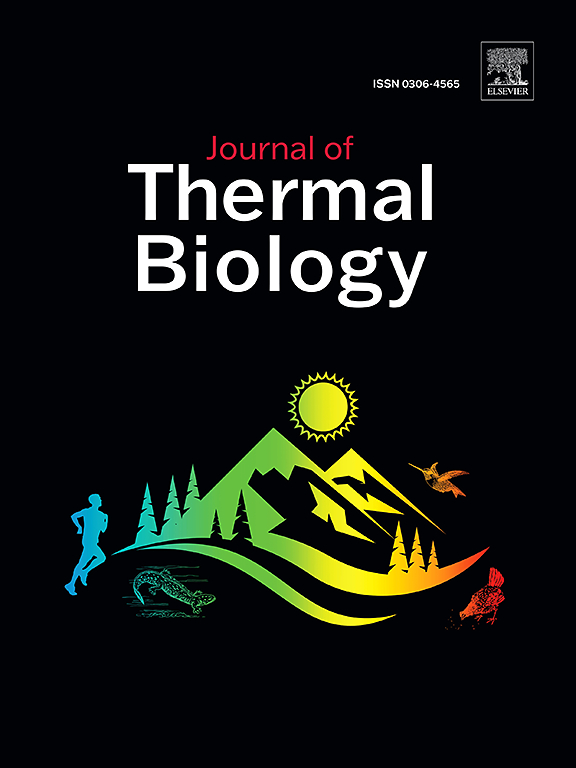亚马逊蜻蜓的微生境选择和体温调节
IF 2.9
2区 生物学
Q2 BIOLOGY
引用次数: 0
摘要
昆虫的生态生理特征对于了解其分布和生境选择非常重要,尤其是在土地利用发生变化的情况下。我们估算了20种蜻蜓(昆虫纲)胸腔表面的平均温度,并根据它们对阳光充足或荫蔽生境的偏好将它们划分为体温调节类别,以评估它们的温度变化。我们测试了气温以及与胸部和腹部大小相关的六个形态指标的影响。我们预计(i) 与变温物种相比,日温物种的胸腔温度较高;(ii) 与无翅类动物相比,颧翅类动物由于体型较小,维持相对于空气的恒定体温的效率较低;(iii) 胸部体积会导致蜻蜓胸腔温度升高,而腹部长度会导致胸腔温度降低。这项研究在东亚马孙流域的 18 条亚马孙溪流进行。正如第一个假设所预测的那样,我们观察到日温型和变温型物种的胸腔温度相差 2.5 °C。鞘翅目和蝶亚目都使用不同的形态和环境变量来控制温度。鞘翅目胸腔温度在气温附近和气温以下波动(-1.28 ± 0.62),而无翅目则保持在气温以上(1.81 ± 1.96)。气温只影响鞘翅目胸腔温度的升高,这支持了我们的第二个假设。第三个假设在鸟纲得到了证实,但在其亚纲中只得到了部分证实。鞘翅目胸腔温度只与腹部长度有关,腹部长度与温度下降成正比。鞘翅目的温度仅与胸部指标有关,尤其是胸部体积,它对温度升高有显著作用。尽管观察到的差异因体型大小而异,但我们注意到一些物种的热特征与上述预测存在偏差。因此,我们强调在蜻蜓温度调节过程中考虑其他生态生理方面的相互作用的重要性。本文章由计算机程序翻译,如有差异,请以英文原文为准。
Microhabitat selection and thermoregulation in amazonian dragonflies
Insect eco-physiological traits are important for understanding their distribution and habitat selection, especially in the face of land use change. We estimated the average temperature of the thoracic surface of 20 Odonata (Insecta) species and classified them into thermoregulation categories according to their preferences for sunny or shaded habitats to assess their temperature variation. We tested the influence of air temperature and six morphological metrics related to thorax and abdomen size. We expected that: (i) heliothermic species would have higher thoracic temperatures compared to thermoconformer species; (ii) Zygopterans, due to their smaller body size, are less efficient at maintaining a constant body temperature relative to the air when compared to anisopterans; (iii) thorax volume would cause an increase in Odonata thoracic temperature, and abdomen length would cause a decrease. The study was conducted at 18 Amazonian streams in Eastern Amazonia. We observed differences of 2.5 °C in thoracic temperature between heliothermic and thermoconformer species, as predicted in the first hypothesis. Both suborders, Zygoptera and Anisoptera, use different morphological and environmental variables to control temperature. While Zygoptera thoracic temperature oscillated near and below air temperature (−1.28 ± 0.62), Anisoptera maintained temperatures above air temperature (1.81 ± 1.96). Air temperature influenced only the increase in Zygoptera thoracic temperature, supporting our second hypothesis. The third hypothesis was corroborated for order Odonata, but partially for its suborders. Zygoptera thoracic temperature was only related to abdomen length, which was proportional to a temperature decrease. Anisoptera temperature showed a relationship only with thoracic metrics, especially thorax volume, which had a significant contribution to temperature increase. Despite the observed differences, which varied according to size, we noted exceptions in the thermal characteristics of some species that deviated from these predictions. Therefore, we emphasize the importance of considering the interaction of other eco-physiological aspects in dragonfly temperature regulation.
求助全文
通过发布文献求助,成功后即可免费获取论文全文。
去求助
来源期刊

Journal of thermal biology
生物-动物学
CiteScore
5.30
自引率
7.40%
发文量
196
审稿时长
14.5 weeks
期刊介绍:
The Journal of Thermal Biology publishes articles that advance our knowledge on the ways and mechanisms through which temperature affects man and animals. This includes studies of their responses to these effects and on the ecological consequences. Directly relevant to this theme are:
• The mechanisms of thermal limitation, heat and cold injury, and the resistance of organisms to extremes of temperature
• The mechanisms involved in acclimation, acclimatization and evolutionary adaptation to temperature
• Mechanisms underlying the patterns of hibernation, torpor, dormancy, aestivation and diapause
• Effects of temperature on reproduction and development, growth, ageing and life-span
• Studies on modelling heat transfer between organisms and their environment
• The contributions of temperature to effects of climate change on animal species and man
• Studies of conservation biology and physiology related to temperature
• Behavioural and physiological regulation of body temperature including its pathophysiology and fever
• Medical applications of hypo- and hyperthermia
Article types:
• Original articles
• Review articles
 求助内容:
求助内容: 应助结果提醒方式:
应助结果提醒方式:


